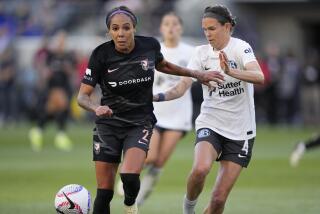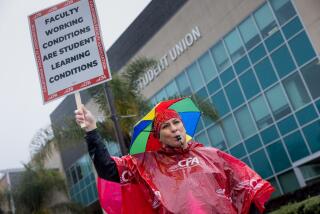NFL owners could approve labor deal as early as Thursday
- Share via
What started in Atlanta could end there too.
It was in that city in May 2008 that NFL owners opted out of their collective bargaining agreement with the players, setting in motion a bitter labor fight that threatened to derail this football season.
And it’s in Atlanta that those owners will convene Thursday for a special meeting, almost surely to approve a new labor deal.
A clear indication of what’s in the works came Monday when the league told team executives they should be prepared to be schooled on the details of a new labor agreement.
George Atallah, spokesman for the NFL Players Assn., told reporters that although a lockout-lifting deal is close, work remains to be done.
“Nobody cheers for you at Mile 25 of a marathon,” Atallah said. “You still have to cross the finish line. There still are things that can get you tripped up, and we’re going to push through.”
Under the new deal, the players would receive between 46% and 48% of total revenue, and owners would not get the $1-billion credit off the top they initially requested. According to several reports, the salary cap for this season will be about $120 million per team (slightly lower than the last cap in place in 2009), and — assuming the agreement is ratified Thursday — free agency will begin Monday, meaning there will be a flurry of high-profile players switching teams.
The new deal will significantly reduce the money paid to rookies selected at the top of the draft, and reportedly will earmark $1 billion in additional pensions and benefits for retired players.
A new CBA will affect the league in many ways beyond the basic division of revenue. It could further open the door to a return to the Los Angeles market — including specific language in the deal to address that — and will underscore the recent push to make the game safer for players.
A look at those potential changes:
Los Angeles
Owners have promised all along that they know how to grow the revenue pie and intend to do so under a new agreement. One of the most obvious ways to do that is by moving a franchise that is struggling financially into the nation’s second-largest market, providing L.A. has the right stadium deal in place. As soon as the labor fight is history, the NFL can turn its attention back to L.A. and help work out a deal.
Owners have long argued that their last labor deal, which began in 2006, wasn’t good enough to justify their investing in new stadiums. In fact, there were no new stadium starts during that agreement (the venues in the Dallas and New York areas were already in the pipeline).
Even if players no longer provide owners with credits against the salary cap for investing in new stadiums, an exception could be made for potential California stadium projects in L.A., the Bay Area and San Diego — a shared investment by owners and players that eventually would be repaid by teams playing in those new stadiums. The possibility that L.A. could be included in the language of the new CBA was first reported by ESPN.
There are two things to remember about this, however. One, this return-to-L.A. saga has bumped along for 16 years with too many false starts to count, so there are no guarantees that now will be the time. And, two, we don’t know how much a new labor agreement will benefit teams. There’s a chance that a club in financial trouble under the old deal will be so much better off that there’s not the same urgency to leave its current market.
Improved player safety
The league is going to continue to tweak rules and procedures in the name of safety, including introducing improved equipment.
Players won’t do as much hitting in training camp or during game weeks, either. According to an individual familiar with the labor negotiations, the new rules could reduce by 33% the number of days allowed for Organized Team Activities, drastically reduce the use of helmets (and therefore hitting) in practice, and ban any team workouts before May 1.
More Thursday games
The current schedule features regular Thursday night games in the second half of the season that air on NFL Network. Within the next two years, watch for the league to bolster its TV money by scheduling those games throughout the season, then selling at least an eight-game package to a network.
There is a strong indication that in the coming years, “Thursday Night Football” will become as much a season-long staple as “Monday Night Football.”
twitter.com/LATimesfarmer
More to Read
Go beyond the scoreboard
Get the latest on L.A.'s teams in the daily Sports Report newsletter.
You may occasionally receive promotional content from the Los Angeles Times.











